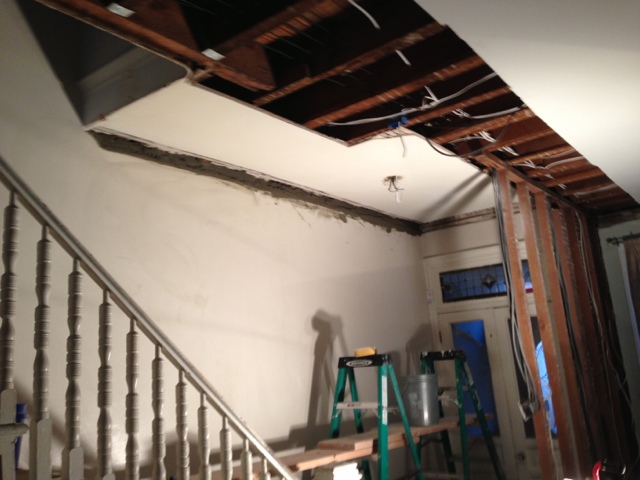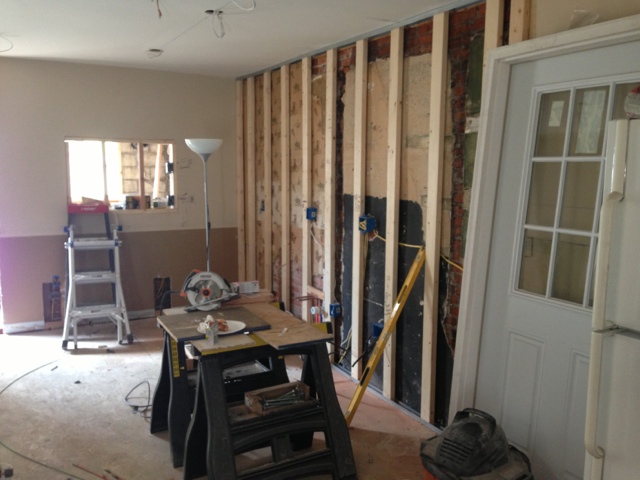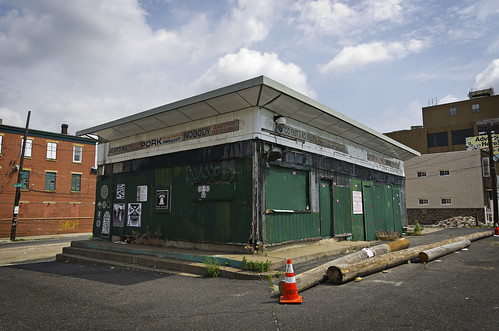 |
| My pre-contruction Sketchup Plan |
When it comes to your home, you want to have a real clear picture of what you are looking to accomplish. Don't know exactly what you want? Go to Pinterest or Houzz and find photos that have elements you would like to replicate. I spent a lot of time planning my kitchen and collected photos of inspiration (view my Houzz IdeaBook here). Do Not rely on your contractor as your first and sole design source. You're sure to have differences on either style, budget, or best use of the space. Spend a few weeks thinking about your designs and ask your friends for their input. I changed my kitchen layout multiple times and one friend really helped me choose a layout that worked exceptionally well. It helps to get outside perspective.
Envision it: Try to plan out your space with SketchUp. I re-created my whole house and was able to see the finished product without lifting a hammer or checkbook. I probably spent 40-60 hours over the course of 2 months to refine my plan.
The more specific your plan, the better prepared you'll be for everything else.
2. Meet with Multiple Contractors, Be Upfront About It
Have a contractor referred to you by someone? That's great! - But please get multiple quotes. When you meet with one, be sure to tell them you're receiving other quotes and from who. Something about getting other quotes without letting the contractors know feels dirty to me, like you're going behind their back. Let them know they are not the only ones bidding on the work. This lets the contractor know you're serious and that they need to give you their best price or they may lose your project. Don't know where to start? Go on Angieslist.com and find crews that have done work in your area. The more you've planned ahead, the better the contractor will be able to understand your needs. I received three quotes for my HVAC system. I showed their competing bids to each other and was able to receive honest feedback. In the end, one HVAC company said "That's a great price and a great system, go with them. Let me know if you need any help in the future." They will respect you for being upfront and honest.
You don't need to choose one contractor for all the work. If the team you choose specializes in structural and framing, you may want to look to someone else for drywall and finish work.
3. Get a Detailed Schedule. Plan for the Worst.
Once you receive your quotes, you'll decide upon the team you want to hire. Many contractors will ask for money up front, with payments in the coming weeks as work progresses. Do Not pay more than 30% up front, I would suggest you provide the first deposit the day the crew shows up to work. Do Not choose a contractor who demands money before showing up to work so he can purchase materials. This is a sign that he isn't managing his business well and is barely staying afloat. Make sure your contract is as itemized as possible.
Settle on a timeline and set weekly goals. Funds should be tied to performance, not how long they've been on the job site. It's not your problem if they need money to help them with another project. Do Not give small amounts of funds as the work continues, instead, try to provide the funds in larger increments, which keeps the contractor motivated. And lastly, set an end date and make sure that all your work is completed before you hand over any final payments.
Things may not go to plan, and you need to ensure that you're ahead through most of the project. That means, the work they've completed is more than the money you've shelled out. Staying ahead means there's less of a chance the contractor goes missing for days and weeks on end.
Settle on a timeline and set weekly goals. Funds should be tied to performance, not how long they've been on the job site. It's not your problem if they need money to help them with another project. Do Not give small amounts of funds as the work continues, instead, try to provide the funds in larger increments, which keeps the contractor motivated. And lastly, set an end date and make sure that all your work is completed before you hand over any final payments.
Things may not go to plan, and you need to ensure that you're ahead through most of the project. That means, the work they've completed is more than the money you've shelled out. Staying ahead means there's less of a chance the contractor goes missing for days and weeks on end.
4. Buy Lunch on Productive Days
When your contractor and his team show up, make sure you're there to say hello to the crew. Getting face time with the people that will be spending a lot of time in your home allows them to get to know you as a person and care more about the quality of their work. One or two of the days when the crew is going full-steam, order a few pizzas. You keep them happy and on the job. You'll more than make back your pizza costs in increased efficiency.5. Track Everything
Keep track of when you signed your initial contract and the dates that were outlined. Take photos of checks you provide, and document all the costs. You should keep a spreadsheet with the work items, when you paid, and what is remaining. Have an important phone call with your contractor? Follow it up with an email summarizing the same conversation which leaves a record of what was said. This is priceless in case there's a discrepancy over what was said and when.6. Keep the Momentum Going
The most stressful part of the job is often the last ten percent, when it feels like the list of remaining items keeps growing. Drywall, paint, handles, lighting fixtures, scuffs and marks... It can seem like the list never ends. Do Not let the work taper off. This is why it's important to stay ahead on your payments. You'll avoid the late project lag if your contractor has to finish all the items on your punch list to get the last lump sum. With my contractor, we never made it to the end and I released him before he was able to finish. Our relationship was soured because we lost momentum.7. End on Good Terms
This is self-explanatory, but at the end of the project there's a chance that you're going to be fed up and ready to move on. It's always best to step back and think about the relationships that you want to foster long term. If you don't plan on working with your GC again, that's fine, but keep it to yourself until the crew is finished and you've finalized everything. Take your final assessment to Angie's List or other review sites and help out the next person looking to hire a contractor.Have your own tips? Please add them below.

















